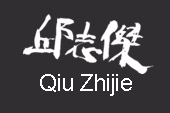 |
Qiu Zhijie adds provocative new meaning to traditional calligraphy |
|||||||
|
The Beijing-based experimental artist Qiu Zhijie has the Chinese character for left carved out of the sole of his right shoe and the character for right on the left sole, and as he demonstrated by gamely stepping in a puddle, they leave a brief, rebellious pattern on the ground as he walks. "I carved those myself in 2002 for a performance related to the Long March. Most of the time you cannot see the pattern, but for me it is a constant reminder of art in my life," he said, while adding he has also carved the tires of his car with the sentence "Actually your destination can be somewhere else." Qiu majored in printmaking at the Zhejiang Academy of Fine Arts, Hangzhou , and at his graduation show in 1992, he presented a maze-like installation of silk prints on tall, glass panels. He is now better known for his conceptual multimedia works involving video, photography and performance, but he has always been a printer at heart. The 39-year-old artist recently completed a six-week residency with the Singapore Tyler Print Institute (STPI). "Coming to the STPI makes me feel like going back to my student days," he said, laughing, "but I never completely left printmaking because many of my performances have links to printing." Once described by the Beijing-based art critic Karen Smith as the "intellectual dynamo of the contemporary art world in China," Qiu is well known for fusing traditional Chinese calligraphy with modern media. In his Tattoo series, started in 1994, he painted Chinese characters on his body and a white background wall behind him as he explored the notion of individuality and invisibility. He has also used "light writing" in many of his photographic works, using an electric torch to write words in the night air that are captured by a digital camera on a prolonged exposure and are then digitally superimposed onto another photograph. The artist calls the process "calli-photo-graphy." In his 1997 conceptual piece titled "Writing 'The Orchid Pavilion' One Thousand Times," he videotaped repeated sessions writing the same piece of a well-known calligraphy on the same sheet of paper over a 10-year period. As the layered words dissolved into solid black ink, he perpetuated yet also obliterated the revered cultural icon. "Qiu Zhijie is interesting for the diversity of his practice, and the way he combines writing and curatorial work with his own explorations as an artist. It is his ability to work together with others, often in directly collaborative ways, that opens him and his work up to a degree of freedom that is unusual within Chinese contemporary art circles," Smith said in an e-mail. "Qiu has never limited himself to one medium, or one approach. That is also what makes his work so dynamic." His latest works at the print institute are part of an overall project on the Nanjing Yangtze River Bridge. This symbol of Chinese Communist might, which was completed in 1968, has become known as the Chinese bridge of death, a favored spot for suicide. "For me, the work done here is like making a conceptual map," Qui said, explaining that some of the works are plans for installations and performances he will do in Shanghai and Beijing next year. These newly produced works explore the notion of nationhood and of geopolitical and psychological attachments with Nanjing City, one of the four ancient Chinese capitals. "Nanjing was once a great city, the capital of the south. But in one of my works I also called it a 'City of Failure,' because it has a really sad history. Over the centuries, people have been killed there many times and today these killings continue as people go to the bridge to kill themselves," he said. "In the past, the key word in our society was revolution, but right now the key word is success. You have only two choices: success or failure. That's the reason why so many people kill themselves on this bridge. They come to this symbolic place, which is so tall, so powerful," he added. While many contemporary Chinese artists have chosen to focus in their work on Tiananmen Square, Qiu believes that that political symbol resonates more with foreigners than Chinese: "I think the Nanking bridge is more deeply linked to the Chinese peoples' memory. Growing up, we would get certificates with the bridge in the background. The bridge was always on the second page of our text book." In the paper-cast "Bridge and Birds," beautiful birds fly around the bridge accompanied by flying filigree cages, where the words "Freedom is Danger" and "Freedom is a Lie" are discreetly inserted. "Are we really free? And when we're free, this is what we do?" he mused.
|